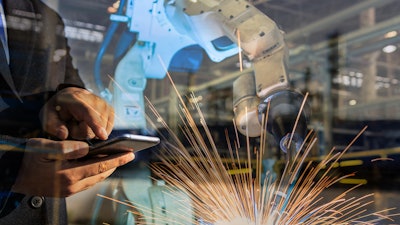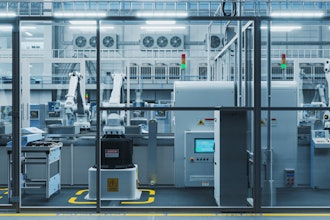
Manufacturing’s growing issue can be summed up in a single word: resiliency.
In recent years, manufacturers and other industrial companies have proven to be dangerously vulnerable to external events, such as unforeseen fluctuations in demand, material costs and availability, and energy prices.
We recently published research that shows why, for these companies, 2024 will be all about mitigating that vulnerability and becoming (more) resilient to disruption in the long term. Just consider that in 2021 and 2022, they lost $3.2 trillion in additional revenue growth because something unforeseen disrupted their engineering, supply or production. Lead times from product order to delivery went up by 40 percent as it took companies too long to react and adapt to quickly changing conditions.
These issues are compounded by the increasing scarcity of engineering and manufacturing talent, from machine operators to experienced line and plant managers who kept plants running through all the disruptions.
This translates into six key priorities, which are reflected in 2024 digital manufacturing strategies and investment plans:
1. No Factory is an Island
In a world where supply and demand volatility are becoming the norm, manufacturers must become much more adaptable in all production-related areas – engineering, the shop floor and the supply chain. Manufacturing can no longer be managed in isolation. Instead, it must be tightly integrated into the supply and product chain.
This means seamless planning between demand and operations, with demand-driven manufacturing as a key objective. Tighter integration between the Enterprise/ERP and Manufacturing Operations Management (MOM) is a must, bridged by integrated business planning.
Having recognized the need, providers of supply chain planning solutions are extending their offerings into production planning and even scheduling. Projects are underway across industries to adopt these solutions, for example, SAP transformations to S/4, most of which provide the opportunity to better integrate with Manufacturing Execution Systems (MES), the backbone of MOM.
Manufacturers also need to be able to adapt their operations to new suppliers, raw materials or parts. This requires the ability to anticipate and simulate these changes to keep production humming through the transition. To achieve this, product and plant designs must be unified and converged into a common simulation environment, and PLM systems must seamlessly integrate into the same MES.
2. The Race to Autonomous, AI-Powered Operations
A growing number of requests for proposals we receive contain the notion of autonomous operations as the end goal of digital roadmaps. Manufacturing decisions that used to be required every week must now be made every day, hour, or in near-real time whenever a disruption occurs. The amount of data needed to make these decisions and the depth of the required analysis is accelerating the adoption of AI. Day-to-day adaptation of operations will increasingly be made by AI. This will free up the time of production managers and engineers to anticipate major trends and keep evolving the plant accordingly.
3. Automation Investments are Increasing
The need for flexibility, combined with the increasing scarcity of skilled labor, drives investments in automation. The new factories companies plan to onshore and re-shore are systematically designed for autonomous operations, which means full automation. This is true for machines, lines, and internal logistics with end-to-end warehousing solutions, where a fleet of AGVs handles all material movements inside the plant.
The most advanced manufacturers design plants and products in parallel, achieving spectacular reductions in the time it takes a new product to market or launch new versions of it. Subsequently, the average investment in digitizing production and supply networks per company will go from approx. $1 billion today to $2.3 billion in three years.
The need is obvious: in the U.S. and Canada, for example, only 10 percent of factory labor (i.e., maintenance and operations) uses technologies that enable remote workers and only 27 percent of companies extensively use artificial intelligence (AI) to reduce quality issues, minimize machine breakdowns, optimize scheduling, reduce other unplanned downtime, or optimize overall operations.
4. Digital Twins are Going Mainstream
More and more manufacturing executives understand that highly adaptive plants—tightly integrated into the supply and product chains and leveraging massive amounts of data and AI to optimize operations automatically—require a new approach. As a result, interest in operational digital twins has been increasing rapidly.
Essentially, an operational twin lets companies tightly integrate ERP, PLM and MES without having to update any of those layers massively. It provides an integrated model of operations, which allows production engineers to discover opportunities for optimization. Data engineers and scientists can then solve these opportunities faster, and the resolution can be deployed across factories. Development and deployment of such advanced data-led optimization use cases typically require 50+ percent less time and effort than traditional approaches to optimization.
Operational twins can also address quality issues and optimize energy consumption, thus supporting more sustainable manufacturing.
5. Generative AI
The productivity potential of the technology, if applied to engineering and manufacturing, is still substantial. Generative AI will be indispensable to accessing and managing knowledge. We are already experimenting with operations copilots, where workers can interrogate the twin as they would an experienced manager to get support. Generative AI will support the early resolution of issues before they can be addressed with repeatable and validated AI solutions.
By the end of 2024, generative AI experimentation will accelerate and have led to concrete realizations. Across our client base, we have seen things happening in a matter of months versus years. Several use cases are ripe for exploring, some of which include:
- Maintenance job planning.
- Generative design and prototyping.
- Code conversion from legacy automation equipment.
6. People Remain at the Center
The need for more skilled labor is no recent development for manufacturers. In the U.S. and other developed economies, an aging workforce and the ongoing reshoring of production capabilities are driving the competition for talent to new heights. The higher the companies set their ambitions to reinvent manufacturing with digital technologies, the bigger the issue becomes.
As automation evolves into semi-autonomous and, eventually, fully autonomous operations, a manufacturer will only survive with strong in-house data and AI expertise. But the technology will also require new skills on the shop floor. One crucial skill that all workers need to have is the ability to use data to make decisions at the frontlines of business.
The growing impact of data and AI will also create new roles. The role of production engineers will evolve from keeping operations running to optimizing those via the twin. Maintenance technicians will prevent failures and plan interventions versus firefighting. Manual operators will program robots and supervise their operation, also using the twin.
Eventually, how people work together will change as well. So-called autonomous teams will independently operate, maintain, schedule and quality manage lines or shops rather than having line or shop operators and departments for planning, scheduling, quality control, maintenance, etc.
No adaptability and resiliency, no sustainable growth.
Disruption has surged to new heights, and unforeseen events will continue to strike manufacturers and other industrial companies where it hurts – production, supply, engineering. Few are truly prepared for it – yet. But manufacturers understand the main levers for making operations more adaptable and resilient. We will see this materialize in technology investments and ambitious transformation agendas across industries.
Pascal Brosset is the global lead for Production & Operations at Accenture Industry X.



















